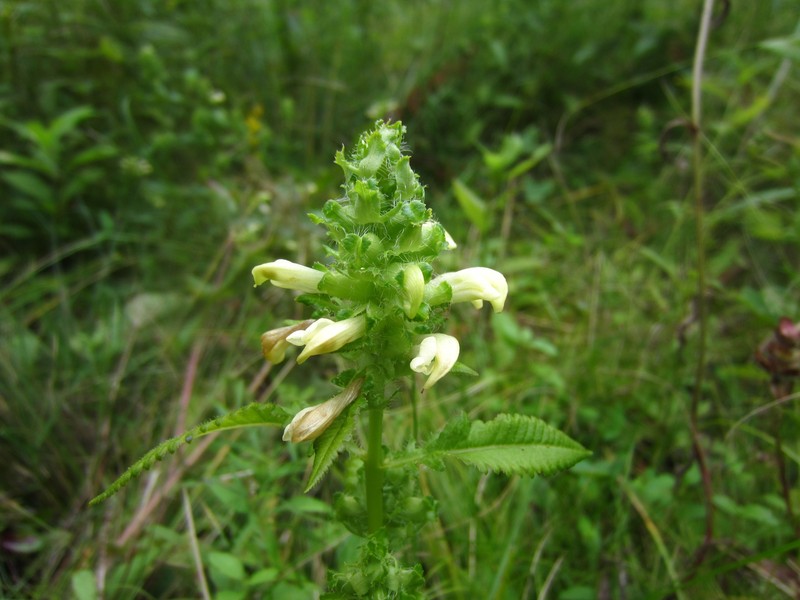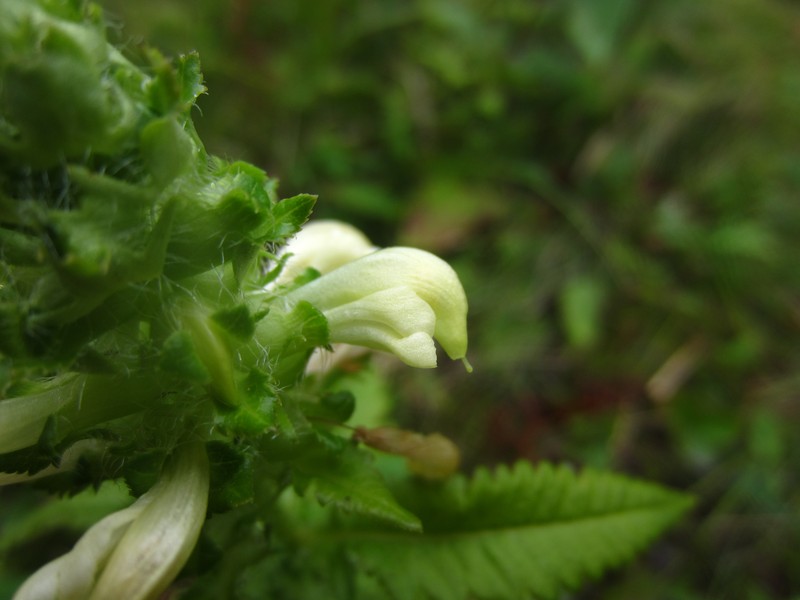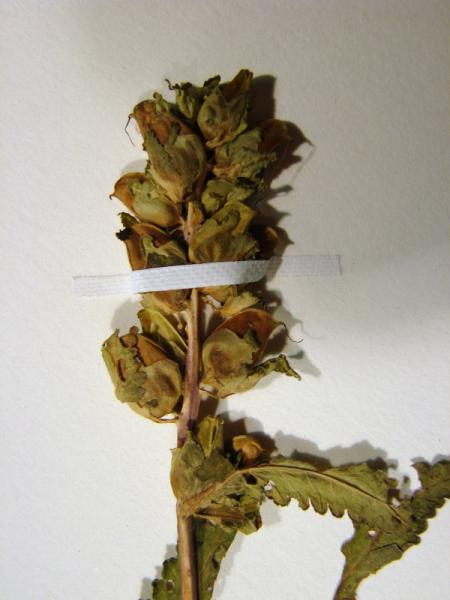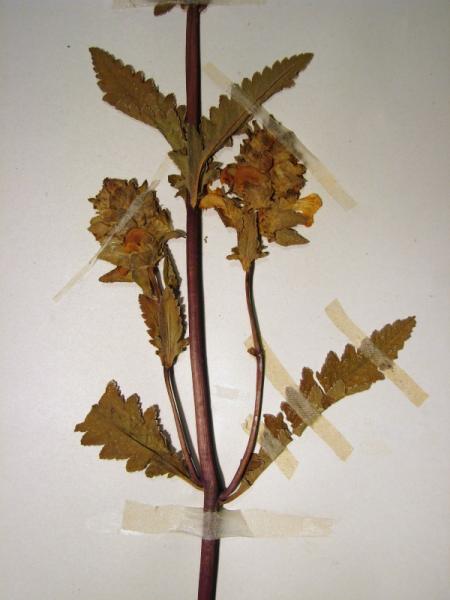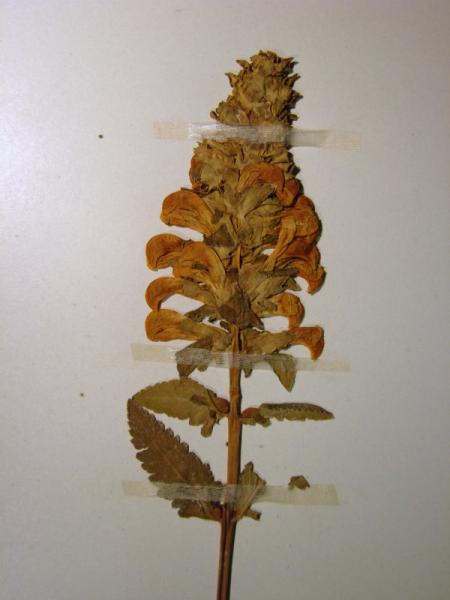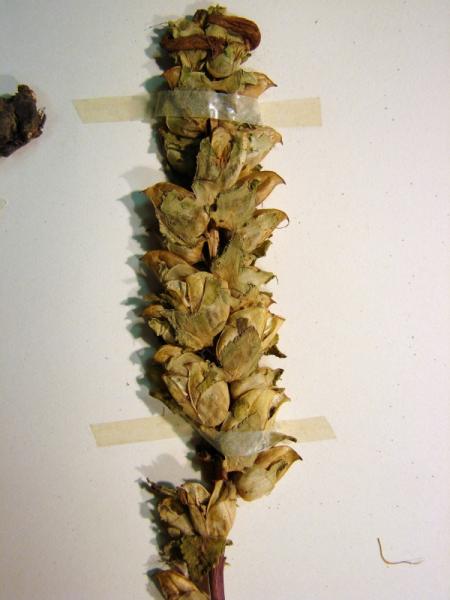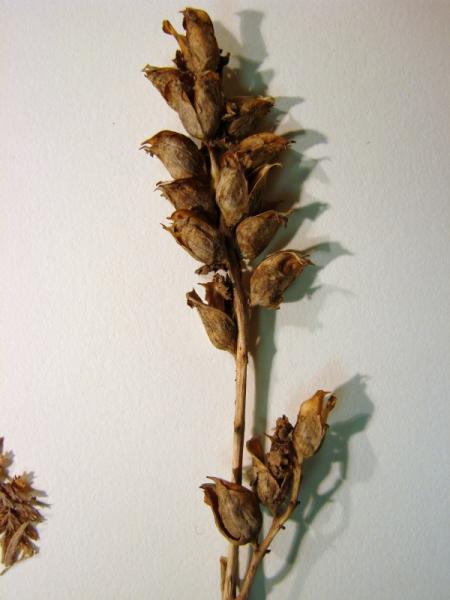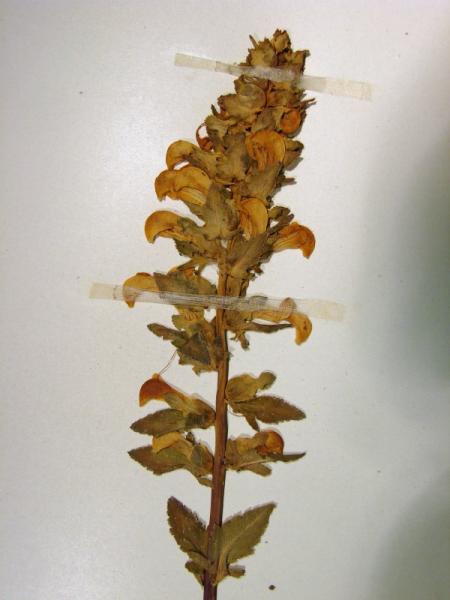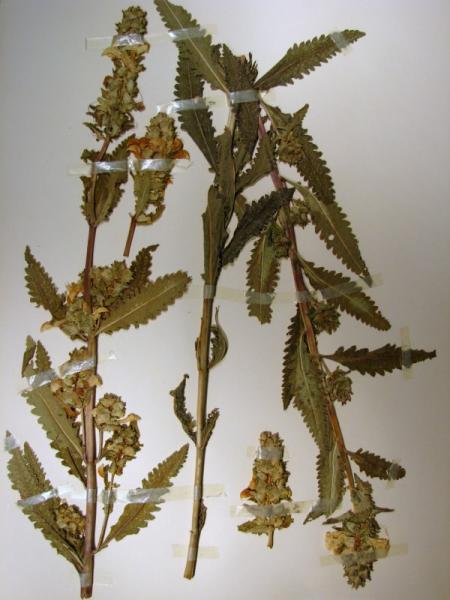Marsh Lousewort
Pedicularis lanceolata Michx.
- Class
- Dicotyledoneae (Dicots)
- Family
- Orobanchaceae (Broom-Rape Family)
- State Protection
- Threatened
Listed as Threatened by New York State: likely to become Endangered in the foreseeable future. For animals, taking, importation, transportation, or possession is prohibited, except under license or permit. For plants, removal or damage without the consent of the landowner is prohibited.
- Federal Protection
- Not Listed
- State Conservation Status Rank
- S2S3
Imperiled or Vulnerable in New York - Very vulnerable, or vulnerable, to disappearing from New York, due to rarity or other factors; typically 6 to 80 populations or locations in New York, few individuals, restricted range, few remaining acres (or miles of stream), and/or recent and widespread declines. More information is needed to assign either S2 or S3.
- Global Conservation Status Rank
- G5
Secure globally - Common in the world; widespread and abundant (but may be rare in some parts of its range).
Summary
Did you know?
The common name lousewort, applied to several species of Pedicularis, derives from an old belief that these plants, when ingested, were responsible for lice infestations in stock (Pedicularis in Wikipedia, accessed 16 November 2007). Like other species of Pedicularis, swamp lousewort is hemiparasitic. This means it is parasitic on the roots of other plants, and draws nutrients directly from them as well as using chlorophyll.
State Ranking Justification
There are 19 existing populations and about half of these are in good to excellent condition with hundreds of plants each. Many of the small populations are in protected areas. About 15 of the 25 historical records have been extirpated by development around the New York City area. There is a small chance that a few historical records from the Lower Hudson region could be rediscovered.
Short-term Trends
The short-term trends seem stable as most populations are large enough and protected to persist.
Long-term Trends
Many of the historical records from the New York City and Lower Hudson area have been extirpated, but this loss has been offset by many new discoveries in central and western New York.
Conservation and Management
Threats
One population near a railroad track could be sprayed by herbicide during track maintenance. The exotic invasive grass Microstegium vimineum may aggressively crowd out plants in their open wetland habitats.
Conservation Strategies and Management Practices
Establish sufficient buffers around populations to preserve the undisturbed aspect and hydrology of their habitat.
Habitat
Habitat
In New York Swamp Lousewort occurs in a variety of wetland habitats, usually with an open or absent canopy. It occupies rich fens, where it may grow among Sphagnum with other calciphilic species, as well as in freshwater tidal marshes and swamps, and along the edges of ponds or shrub swamps. This species may benefit from some level of disturbance, as many of the known sites for it have been grazed or cut-over, or are along roadsides, right-of-ways, and trails. (New York Natural Heritage Program 2007). Rich, often calcareous, meadows and shores (Fernald 1970). Swamps and wet soil (Gleason 1952).
Associated Ecological Communities
- Freshwater tidal swamp
(guide)
A forested or shrub-dominated tidal wetland that occurs in lowlands along large river systems characterized by gentle slope gradients coupled with tidal influence over considerable distances. The swamp substrate is always wet and is subject to semidiurnal flooding by fresh tidal water (salinity less than 0.5 ppt).
- Marl fen
(guide)
A wetland that occurs on a bed of marl. Marl is a whitish substance that is deposited from water that has a lot of calcium dissolved in it. The whitish substance is calcium carbonate, people used to harvest marl to lime agricultural fields. The marl substrate is always saturated, may be flooded, and has a very high pH, generally greater than 7.5. The main source of water is always groundwater. The plants are often sparse and stunted. Marl fens may occur as small patches within a rich graminoid fen.
- Red maple-hardwood swamp
(guide)
A hardwood swamp that occurs in poorly drained depressions, usually on inorganic soils. Red maple is usually the most abundant canopy tree, but it can also be codominant with white, green, or black ash; white or slippery elm; yellow birch; and swamp white oak.
- Rich graminoid fen
(guide)
A wetland of mostly grasses usually fed by water from highly calcareous springs or seepage. These waters have high concentrations of minerals and high pH values, generally from 6.0 to 7.8. Plant remains do not decompose rapidly and these grasses usually grow on older, undecomposed plant parts.
- Shrub swamp
(guide)
An inland wetland dominated by tall shrubs that occurs along the shore of a lake or river, in a wet depression or valley not associated with lakes, or as a transition zone between a marsh, fen, or bog and a swamp or upland community. Shrub swamps are very common and quite variable.
Associated Species
- Acer rubrum
- Acorus americanus (American sweet-flag)
- Agrimonia parviflora (southern agrimony)
- Alnus incana ssp. rugosa (speckled alder)
- Alnus serrulata (smooth alder)
- Amphicarpaea bracteata (hog peanut)
- Angelica atropurpurea (purple-stemmed angelica)
- Apios americana (groundnut)
- Cardamine parviflora (small-flowered bitter cress)
- carex cristatella
- Carex aurea (golden-fruited sedge)
- Carex bromoides
- Carex comosa (bristly sedge)
- Carex hystericina (porcupine sedge)
- Carex prasina (elegant drooping sedge)
- Carex stricta (tussock sedge)
- Carex vulpinoidea (fox sedge)
- Ceanothus americanus (New Jersey-tea)
- Cephalanthus occidentalis (buttonbush)
- Chelone glabra (white turtle-head)
- Cornus amomum
- Cornus racemosa (gray dogwood, red-panicled dogwood)
- Dasiphora fruticosa (shrubby-cinquefoil)
- Desmodium paniculatum (panicled tick-trefoil)
- Eleocharis erythropoda (red-footed spike-rush)
- Eleocharis rostellata (walking spike-rush)
- Equisetum arvense (field horsetail, common horsetail)
- Equisetum fluviatile (river horsetail)
- Equisetum variegatum
- Erigeron philadelphicus
- Eupatorium perfoliatum (boneset)
- Eutrochium maculatum
- Gentianopsis crinita (common fringed gentian)
- Hypnum lindbergii
- Impatiens capensis (spotted jewelweed, spotted touch-me-not)
- Iris pseudacorus (yellow iris)
- Iris versicolor (blue flag)
- Juncus nodosus (knotted rush)
- Larix laricina (tamarack)
- Leersia oryzoides (rice cut grass)
- Lemna minor (common duckweed)
- Lindera benzoin (spicebush)
- Lindernia dubia
- Lobelia kalmii (Kalm's lobelia)
- Lobelia siphilitica
- Lonicera morrowii (Morrow's honeysuckle)
- Lycopus uniflorus (northern bugleweed, northern water-horehound)
- Lythrum salicaria (purple loosestrife)
- Maianthemum stellatum (starry Solomon's-seal)
- Monarda fistulosa
- Muhlenbergia mexicana (hairy wire-stemmed muhly)
- Myosotis scorpioides (water forget-me-not)
- Myrica pensylvanica
- Onoclea sensibilis (sensitive fern)
- Osmunda regalis
- Packera aurea (golden ragwort)
- Parnassia glauca (common grass-of-Parnassus)
- Persicaria arifolia (halberd-leaved tear-thumb)
- Phragmites australis (old world reed grass, old world phragmites)
- Physocarpus opulifolius (ninebark)
- Pilea fontana (black-fruited clearweed)
- Pilea pumila
- Populus tremuloides (trembling aspen, quaking aspen)
- Ranunculus acris (tall butter-cup, tall crow-foot)
- Rosa palustris (swamp rose)
- Salix discolor (pussy willow)
- Sambucus nigra
- Scirpus atrovirens (dark-green bulrush)
- Scleria verticillata (low nut sedge)
- Scutellaria lateriflora (mad-dog skull-cap)
- Solidago patula (rough-leaved goldenrod)
- Solidago rugosa
- Spirodela polyrrhiza
- Symphyotrichum puniceum
- Thelypteris palustris
- Toxicodendron vernix (poison-sumac)
- Triglochin palustris (marsh arrow-grass)
- Typha latifolia (wide-leaved cat-tail)
- Ulmus rubra (slippery elm)
- Vaccinium corymbosum (highbush blueberry)
- Veronicastrum virginicum (Culver's-root)
- Viburnum dentatum
- Viburnum lentago (nannyberry)
Range
New York State Distribution
Swamp lousewort has been found at scattered locations throughout the state south of the Adirondacks, primarily in the Hudson Valley and in the western part of the state.
Global Distribution
Swamp Lousewort is found from lower New England and New York, south to North Carolina and Georgia in the east, and from Ontario and Manitoba south as far as Arkansas in the west. It is considered a species of conservation concern in most of the states in which it occurs east of the Ohio River.
Identification Comments
General Description
Swamp lousewort is an herbaceous wetland wildflower growing in usually solitary stalks from 3 to 8 dm high. The leaves are opposite, 5-10 cm long, and pinnately lobed less than halfway to the midvein throughout, somewhat resembling the pinnae of a fern. The pale yellow flowers are 15 to 25mm long and born in a dense spike near the top of the stem. They are 2-lipped, the upper lip galeated (hooded) and exceeding the lower to form a beak-like shape. The fruit are dry capsules, mostly hidden from view by the green calyx.
Best Life Stage for Proper Identification
Swamp lousewort is most easily spotted when in flower, but can be identified from vegetative or fruiting stems as well.
Similar Species
Pedicularis canadensis is shorter, usually forming clumps with many crowded basal leaves, and has petioled leaves scattered on the stem, not opposite. It also is primarily a plant of uplands, not wetlands.
Best Time to See
Pedicularis lanceolata flowers from late August to early October, and fruits persist to the end of November or sometimes until the next spring.
- Vegetative
- Flowering
- Fruiting
The time of year you would expect to find Marsh Lousewort vegetative, flowering, and fruiting in New York.
Marsh Lousewort Images
Taxonomy
Marsh Lousewort
Pedicularis lanceolata Michx.
- Kingdom Plantae
- Phylum Anthophyta
- Class Dicotyledoneae
(Dicots)
- Order Scrophulariales
- Family Orobanchaceae (Broom-Rape Family)
- Order Scrophulariales
- Class Dicotyledoneae
(Dicots)
- Phylum Anthophyta
Additional Common Names
- Lousewort
- Swamp Lousewort
- Wood-betony
Additional Resources
Best Identification Reference
Gleason, Henry A. and A. Cronquist. 1991. Manual of Vascular Plants of Northeastern United States and Adjacent Canada. The New York Botanical Garden, Bronx, New York. 910 pp.
Other References
Crow, Garrett E. and C. Barre Hellquist. 2000. Aquatic and Wetland Plants of Northeastern North America: A revised and enlarged edition of Norman C. Fassett's a Manual of Aquatic Plants. Volume One: Pteridophytes, Gymnosperms, and Angiosperms: Dicotyledons. The University of Wisconsin Press. Madison, Wisconsin. 536 Pages.
Fernald, M.L. 1950. Gray's manual of botany. 8th edition. D. Van Nostrand, New York. 1632 pp.
Holmgren, Noel. 1998. The Illustrated Companion to Gleason and Cronquist's Manual. Illustrations of the Vascular Plants of Northeastern United States and Adjacent Canada. The New York Botanical Garden, Bronx, New York.
New York Natural Heritage Program. 2010. Biotics database. New York Natural Heritage Program. New York State Department of Environmental Conservation. Albany, NY.
New York Natural Heritage Program. 2024. New York Natural Heritage Program Databases. Albany, NY.
Newcomb, Lawrence. 1977. Newcomb's Wildflower Guide: An Ingenious New Key System for Quick, Positive Field Identification of the Wildflowers, Flowering Shrubs, and Vines of Northeastern and North-Central North America. Little, Brown and Company. Boston.
Rhoads, Ann F. and Timothy A. Block. 2000. The Plants of Pennsylvania, an Illustrated Manual. University of Pennsylvania Press, Philadelphia, PA.
Voss, Edward G. 1996. Michigan Flora Part III. Dicots Concluded (Pyrolaceae - Compositae). Cranbrook Institute of Science Bulletin 61 and University of Michigan Herbarium. 622 pp.
Weldy, T. and D. Werier. 2010. New York flora atlas. [S.M. Landry, K.N. Campbell, and L.D. Mabe (original application development), Florida Center for Community Design and Research http://www.fccdr.usf.edu/. University of South Florida http://www.usf.edu/]. New York Flora Association http://newyork.plantatlas.usf.edu/, Albany, New York
Weldy, Troy W. and David Werier. 2005. New York Flora Atlas. [S.M. Landry, K.N. Campbell, and L.D. Mabe (original application development), Florida Center for Community Design and Research. University of South Florida]. New York Flora Association, Albany, NY. Available on the web at (http://newyork.plantatlas.usf.edu/).
Links
About This Guide
Information for this guide was last updated on: February 1, 2023
Please cite this page as:
New York Natural Heritage Program. 2024.
Online Conservation Guide for
Pedicularis lanceolata.
Available from: https://guides.nynhp.org/swamp-lousewort/.
Accessed July 26, 2024.
